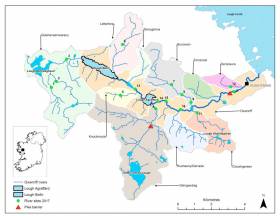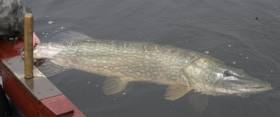Displaying items by tag: Owenriff Catchment
Plan Published For Recovery Of Salmon & Trout Stocks In Owenriff Catchment
#Angling - Inland Fisheries Ireland has published its 2017 fish stock survey for the Owenriff catchment as well as its rehabilitation plan for the system to promote the recovery of brown trout and salmon in its lakes and rivers.
The Fish Stock Survey — which was conducted in the summer of 2017 and forms the basis for the Rehabilitation Plan — deduces that the introduction of pike into the catchment has been the significant factor in the declining fish stocks.
“As there are little or no major anthropogenic pressures in the catchment to cause the decline in fish stocks, it is reasonable to infer that the introduction of pike and their subsequent range expansion in the Owenriff catchment (with impacts of competition for food and space and predation on resident and migratory fish) is the main factor causing the decline of brown trout and salmon in the Owenriff catchment. Research from Europe and North America supports this finding,” the reports states.
Anthropogenic pressures include human-induced factors such as urban growth, deleterious discharges, farming activities and introduction of alien species.
Although pike were captured for the first time by IFI staff in 2009 in two lakes in the catchment (Loughs Bofin and Agraffard) and efforts were made by IFI staff to remove the pike from the system, they did not show up in two catchment-wide surveys in 1997 and 2007 and were only officially recorded in a survey for the first time in 2015.
However, the latest report, from the 2017 survey, confirms that pike are present all over the Owenriff catchment “in areas where they can freely gain access and in some areas where they cannot naturally gain access.”
Welcoming the publication of the two reports, Minister Sean Kyne TD said: “We have acted swiftly since the interim results of this survey became known. In late January, I announced that Inland Fisheries Ireland is to commence fish stock management operations on the Owenriff catchment to protect and restore trout stocks which have been impacted by recent introductions of pike to the catchment.
“The consequences of not taking wider remedial action on the basis of these survey results would lead to further decline in ecological biodiversity in the catchment, so I very much welcome the publication by IFI of the Owenriff Fish Population Rehabilitation Plan 2018.”
The minister continued: “The purpose of the plan is to develop a fisheries rehabilitation project that can be undertaken on the catchment to promote the recovery of the brown trout (both resident and migratory Corrib) and salmon populations in both lakes and rivers. It will take time and will be costly, but we are already underway with this very constructive and positive roadmap.”
With stock management actions having already commenced, the success of the broader rehabilitation project will depend on applying the correct tools to rehabilitate the brown trout and salmon populations in the Owenriff catchment.
These include fisheries enhancement works in selected sub-catchments to favour brown trout and salmon; genetic restoration; removing the problem (pike control); reducing anthropogenic impacts in the catchment; public awareness (especially in relation to the impacts of the introductions of species not indigenous to an area); interagency co-ordination; climate change mitigation; and any other necessary measures.
The Owenriff catchment is located on the north-western end of the Lough Corrib catchment, and the main Owenriff River drains into Lough Corrib Upper downstream of Oughterard, Co Galway. The Lough Corrib catchment itself is the largest and most important wild salmonid catchment in Ireland, and Lough Corrib is considered the premier wild brown trout fishery in Ireland.
The Owenriff rehabilitation plan and 2017 fish stock survey can both be downloaded from the IFI website. Afloat.ie also has more on IFI's stock management plan for Ireland's trout waters in 2018.
Fish Stock Management Plan Launched For Owenriff Catchment
#Angling - Sean Kyne, Minister of State with responsibility for the inland fisheries sector, has announced that Inland Fisheries Ireland will shortly commence fish stock management operations on the Owenriff catchment near Oughterard in Co Galway.
The measures to protect and restore trout stocks, which have been impacted by recent introductions of pike to the catchment, were promised last November upon the development by IFI of a specific stock management plan.
“The Owenriff catchment is one of the most important spawning and nursery tributaries of Lough Corrib, our most renowned wild trout fishery,” said Minister Kyne as he made the announcement today (Monday 29 January).
“Previous scientific studies have shown it contributed 15% of the wild trout found in Lough Corrib, and each year thousands of wild trout and salmon migrate upstream into the Owenriff to spawn.
“I am committed to protecting and rehabilitating the system and welcome IFI’s stock management plan which I have asked to be implemented immediately.”
IFI will be commencing a focused and intensive effort aimed at reducing the numbers of pike in the Owenriff catchment over the coming year.
While pike cannot be completely eradicated, the project will reduce numbers to a level where they are not impacting significantly on salmonid stocks.
It is expected that ongoing maintenance operations will be required in future years to help maintain the trout population.
Minister Kyne also emphasised that, in tandem with the stock management plan, IFI is also preparing an Owenriff Fish Population Rehabilitation Plan which aims to ensure trout stocks and habitats are restored and protected, thereby providing the best opportunities for a successful trout population. The plan will be available shortly.
Survey results are currently being compiled and will be available from the IFI website. Further information on the stock management plan is available HERE.





























































